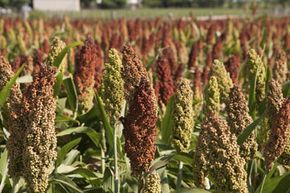Alongside a country road in rural Kentucky, it's pretty common to see rows of corn stretching all the way to the horizon, but all of those green stalks might not actually be corn plants. On closer inspection, you wouldn't see any ears, and the head of the plant looks a little bit more like wheat than corn [source: In the Field]. What you're probably looking at is sweet sorghum.
The sorghum plant is actually a grass that's native to Egypt and spread throughout the rest of Africa [source: Oklahoma 4H]. Farmers in the U.S. have been growing sweet sorghum and using the stalks to produce syrup since at least the mid-1800s [source: Wittgreve]. Sorghum is a grain, and sweet sorghum is a specific variety selected for its higher sugar content [source: Food and Agriculture Organization]. What makes sweet sorghum especially attractive to farmers is its drought resistance. It doesn't require a lot of water, so it's an ideal crop for areas that don't see a lot of rainfall, like parts of China and Africa as well as in the U.S.
Advertisement
Processed syrup from the sorghum plant is amber in color and looks a lot like maple syrup [source: Mallon]. In fact, you can basically treat it like maple syrup in recipes, and some folks even use it to top their pancakes. Farmers also mix the leavings from making sorghum syrup into animal feed, but food for people and animals isn't the main use for sweet sorghum. It's become a cash crop since researchers discovered that we can use sorghum syrup to produce biofuels.
As the U.S. suffers from crippling droughts in many of its farming regions, sweet sorghum's popularity is skyrocketing. Sweet sorghum farming used to take place mainly in the southeast United States, but now farmers in the Corn Belt are jumping on the sorghum train as droughts destroy their corn crops. Sweet sorghum's multiple uses -- as food and fuel -- make it an attractive alternative to corn for many farmers [source: Baragona].
Advertisement

